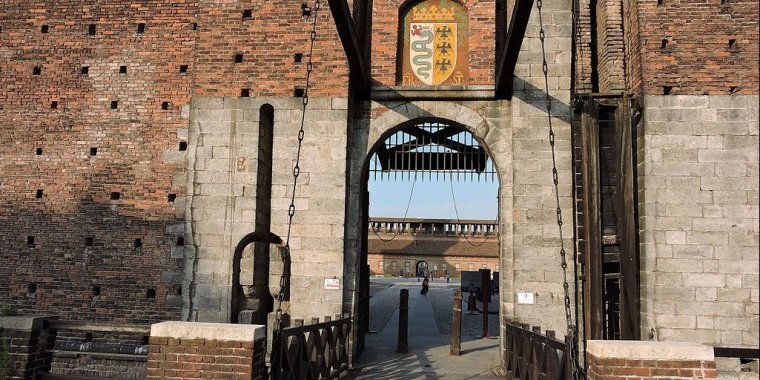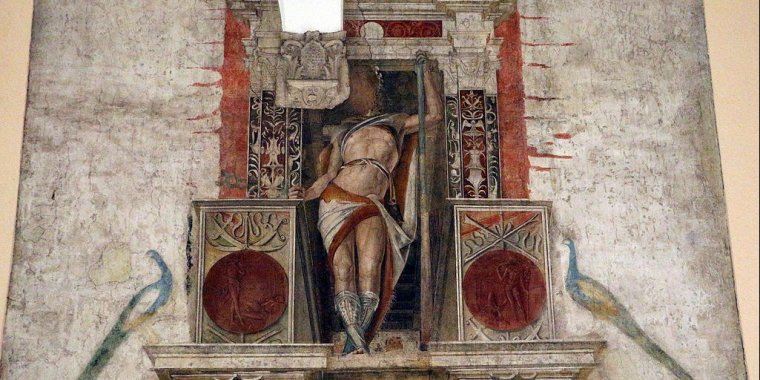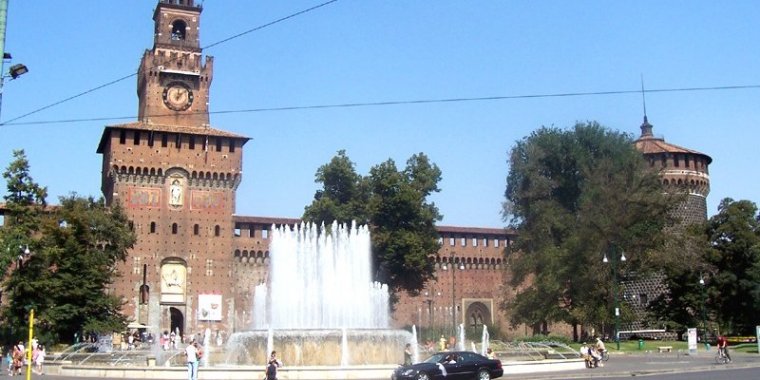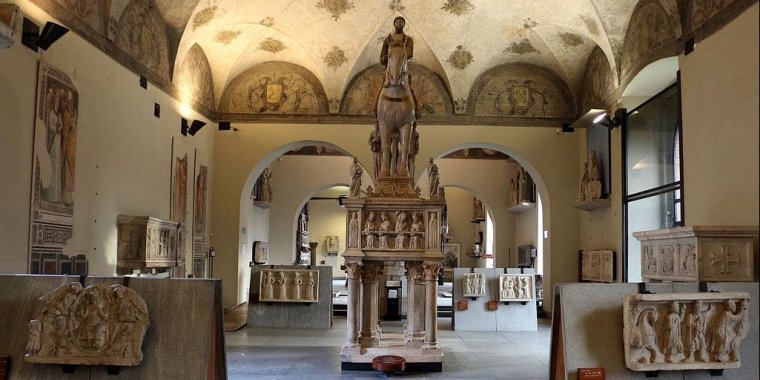| Published in Attractions / Places of Interest |
Sforza Castle (Castello Sforzesco), Milan, Italy
Sforza Castle (Castello Sforzesco) is in Milan, northern Italy. It was built in the 15th century by Francesco Sforza, Duke of Milan, on the remnants of a 14th-century fortification. Later renovated and enlarged, in the 16th and 17th centuries it was one of the largest citadels in Europe. Extensively rebuilt by Luca Beltrami in 1891–1905, it now houses several of the city's museums and art collections.
The original construction was ordered by local lord Galeazzo II Visconti in 1358–c. 1370; this castle was known as Castello di Porta Giova (or Porta Zubia), from the name of a gate in walls located nearby. His successors Gian Galeazzo, Giovanni Maria and Filippo Maria Visconti enlarged it, until it became a square-plan castle with 200 m-long sides, four towers at the corners and up to 7-metre-thick (23 ft) walls.
The castle was the main residence in the city of its Visconti lords, and was destroyed by the short-lived Golden Ambrosian Republic which ousted them in 1447.
In 1450, Francesco Sforza, once he shattered the republicans, began reconstruction of the castle to turn it into his princely residence. In 1452 he hired sculptor and architect Filarete to design and decorate the central tower, which is still known as Torre del Filarete.
After Francesco's death, the construction was continued by his son Galeazzo Maria, under architect Benedetto Ferrini. The decoration was executed by local painters. In 1476, during the regency of Bona of Savoy, the tower with her name was built.

One of four entrance of Sforza Castle. ![]()
In 1494 Ludovico Sforza became lord of Milan, and called numerous artists to decorate the castle. These include Leonardo da Vinci (who frescoed several rooms, in collaboration with Bernardino Zenale and Bernardino Butinone) and Bramante, who painted frescoes in the Sala del Tesoro; the Sala della Balla was decorated with Francesco Sforza's deeds.
Around 1498, Leonardo worked at the ceiling of the Sala delle Asse, painting decorations of vegetable motifs. In the following years, however, the castle was damaged by assaults from Italian, French and German troops; a bastion, known as tenaglia was added, perhaps designed by Cesare Cesariano. After the French victory in the 1515 Battle of Marignano, the defeated Maximilian Sforza, his Swiss mercenaries, and the cardinal-bishop of Sion retreated into the castle.
However, King Francis I of France followed them into Milan, and his sappers placed mines under the castle's foundations, whereupon the defenders capitulated. In 1521, in a period in which it was used as a weapons depot, the Torre del Filarete exploded. When Francesco II Sforza returned briefly to power in Milan, he had the fortress restored and enlarged, and a part of it adapted as residence for his wife, Christina of Denmark.
Under the Spanish domination which followed, the castle became a citadel, as the governor's seat was moved to the Ducal Palace (1535). Its garrison varied from 1,000 to 3,000 men, led by a Spanish castellan. In 1550 works began to adapt the castle to modern fortification style, as a hexagonal (originally pentagonal) star fort, following the addition of 12 bastions.
The external fortifications reached 3 km in length and covered an area of 25.9 hectares. The castle remained in use as a fort also after the Spaniards were replaced by the Austrians in Lombardy.
Most of the outer fortifications were demolished during the period of Napoleonic rule in Milan under the Cisalpine Republic. The semi-circular Piazza Castello was constructed around the city side of the castle, surrounded by a radial street layout of new urban blocks bounded by the Foro Buonoparte. The area on the "country" side of the castle was laid out as a 700-by-700-metre (2,300 by 2,300 ft) square parade ground known as Piazza d'Armi.
After the unification of Italy in the 19th century, the castle was transferred from military use to the city of Milan. Parco Sempione, one of the largest parks in the city, was created on the former parade grounds.
The government of Milan undertook restoration works, directed by Luca Beltrami. The Via Dante was cut through the medieval street layout in the 1880s to provide a direct promenade between the castle and the Duomo on axis with the main gate. The central tower, known as the Torre Filarete, above the main city entrance was rebuilt, on the basis of 16th-century drawings, between 1900 and 1905 as a monument to King Umberto I.
Allied bombardment of Milan in 1943 during World War II severely damaged the castle. The post-war reconstruction of the building for museum purposes was undertaken by the BBPR architectural partnership.

Castello Sforzesco (Milan) - Interior. ![]()
Description
The castle has a quadrangular plan, on a site across the city's walls. The wall which once faced the countryside north to Milan has square towers and has an ogival gate. This was once accessed through a drawbridge. The northern tower is known as Torre della Corte, while the western one is called ''Torre del Tesoro: both received wide windows during the Sforza age.
The corner defended by the Torre Ducale is characterized by a loggia bridge, attributed to Bramante, and commissioned by Ludovico Sforza in the late 15th century to connect the Corte Ducale (the court in the area used as ducal residence) and the Cortile della Ghirlanda. This ghirlanda refers to a wall, protected by a ditch filled by water, built under Francesco Sforza, of which few traces remain today, including the Porta del Soccorso.
Remains of two later ravelins can be seen in correspondence of the point in which the castle was joined by the city walls (near the Porta Comasina gate) and the Porta del Carmine. The Porta della Ghirlanda gate was entered through a ravelin (now lost) and had two entrances accessed through runways, on which lead to an underground passage which continued along the walls.
The external side which once faced the walled city has two round towers, commissioned by Francesco Sforza to replace the former square ones, which had become less suitable to defend against fire weapons. The central tower, called Torre del Filarete, is a modern reconstruction.
The round towers lost the upper parts under the Austrians, which needed open space for their artillery. Their upper sector existing today is also a modern restoration. The Torre del Filarete and the Porta del Santo Spirito, located more southwards, are both preceded by a ravelin.
The main gate leads to a large court from which several internal features can be seen. These include the Tower of Bona of Savoy (1476) and the Rocchetta, a sort of internal defensive ridotto with a gate of its own. At the right of the Porta del Carmine are remains of two 15th century courts.
The Rocchetta, whose access gate from the main court (a modern addition) features the coat of arms of the Sforza, has an internal courts with, on three sides, a portico with 15th century arcades. The Corte Ducale is the wing of the castle originally used as ducal residence; it features a court with two loggias, a smaller one at left and a larger one at its end, called Loggiato dell'Elefante due to the presence of a fresco of an elephant.
The Castello complex includes some museums:
• The Pinacoteca del Castello Sforzesco, with an art collection which includes Andrea Mantegna's Trivulzio Madonna and masterpieces by Canaletto, Tiepolo, Vincenzo Foppa, Titian and Tintoretto.
• The Museum of Ancient Art which includes the armory, the tapestry room and some funerary monuments.
• The Museum of Musical Instruments.
• The Egyptian Museum.
• The Prehistoric collections of the Archaeological Museum of Milan.
• Applied Arts Collection.
• The Antique Furniture & Wooden Sculpture Museum.
• The Achille Bertarelli Print Collection.
• The Museum of Rondanini Pietà which includes Michelangelo's last sculpture (the Rondanini Pietà)
The Trivulziana Library holds Leonardo da Vinci's 'Codex Trivulzianus' manuscript. Also in 2012 new paintings attributable to Michelangelo Merisi da Caravaggio have been discovered at the castle.
Address: Castello Sforzesco, Piazza Castello - 20121 Milano
How to find:
By tube
M1 (Linea rossa): stop on Cairoli or Cadorna FN
M2 (Linea verde): stop on Lanza or Cadorna FN
By tram
Line 1, 2, 4, 12, 14, 27
By bus
Line 50, 57, 58, 61, 94
Opening times:
Castle: Monday-Sunday 7.00-19.30
Museums: Tuesday-Sunday 9.00-17.30. Last admission 17.00 (only for ticket holders). Closed on Mondays, December 25th, January 1st, May 1st
Admission:
Free entry: every first and third Tuesday of the month from 14.00
Every Saturday at 15.00 guided tour Leonardo mai visto and Museums highlights 8,00 eur (max 25 people, without reservation, meeting point at 14.45 in Porta Giovia, in the middle of the Castle)
Admission ticket: Tuesday-Sunday 9.00-16.30
Full ticket 10,00 eur
Reduced 8,00 eur
Reduced first Sunday of the month 5,00 eur
A ticket is valid for one day and includes the entrance to all the Castle Museums and Leonardo mai visto exhibitions
Sources
• www.wikipedia.org
• www.milanocastello.it
YOU MAY ALSO LIKE






 If you own or manage a travel-related business such as a hotel, a bed-and-breakfast, a restaurant, a pub or a cafeteria, you can create a web page for your business for free on Titi Tudorancea Travel Info. » |

